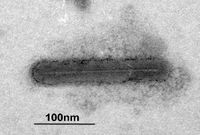Baculoviridae: Difference between revisions
No edit summary |
No edit summary |
||
| (2 intermediate revisions by the same user not shown) | |||
| Line 1: | Line 1: | ||
{{Curated}} | |||
{{Viral Biorealm Family}} | |||
[[Image:Baculovirus.jpg|thumb|200px|right|Electron micrograph of a baculovirus. From [http://www.mardre.com/homepage/mic/tem/samples/bio/virus/virus.htm Marcus Drechsler, U. Bayreuth].]] | [[Image:Baculovirus.jpg|thumb|200px|right|Electron micrograph of a baculovirus. From [http://www.mardre.com/homepage/mic/tem/samples/bio/virus/virus.htm Marcus Drechsler, U. Bayreuth].]] | ||
Latest revision as of 00:19, 8 August 2010
A Viral Biorealm page on the family Baculoviridae

Baltimore Classification
Higher order taxa
Virus; dsDNA viruses, no RNA stage; Baculoviridae
Genera
Granulovirus, Nucleopolyhedrovirus
Description and Significance
Baculoviruses infect insect larvae, causing an infection which eventually turns the host organism into a liquid as the new viruses are released into the environment. The virus family has been known for hundreds of years, with the earliest accounts being about the "wilting" of Chinese silk worms in the 16th century. In the early 20th century a viral infection was discovered to be the cause of this "wilting," and in 1947 the rod-shaped virions which are characteristic of baculoviruses were first seen. There is some discussion currently as to whether the genera in the Baculoviridae family should be reclassified. The reasons for this will be discussed in the next section. (source: Herniou et al.)
Genome Structure
The baculovirus genome is non-segmented and contains a molecule of circular, double-stranded DNA. The complete genome sequence is 80000-180000 nucleotides long. Interspersed throughout the genome are sections of repetitive sequences of DNA known as homologous regions, or hrs. The complex structure of these hrs are formed by 60bp repeats, with each repeat containing a 28bp-long imperfect palindrome. These homologous regions enhance early transcription as well as act as origins for DNA replication. Many of the genes in the baculovirus genome overlap at the ends, which allows a large number of genes to be encoded in a small amount of DNA. (sources: ICTVdB and Viral Bioinformatics Resource Center)
Recent analysis of the genome sequence of baculoviruses suggests that the taxonomy of baculoviruses needs to be altered. More specifically, it has been discovered that the phylogeny of baculoviruses is more closely related to the classification of the host organism than the morphological traits of the virus, which had been used previously to classify baculoviruses. (source: Jehle et al. and ICTVdB)
Viron Structure of a Baculovirus
Baculovirus virions have a complex structure which consists of an envelope and a rod-shaped nucleocapsid. The capsid is 200-450nm in length, and 30-100nm in diameter. The capsid has helical symmetry.
When the baculoviruses are extracellular, they can be found in two forms: budded virus (BV) and occluded virus (OV). OVs are polyhedral or oval-shaped crystalline protein matrices in which one or several mature virions are embedded. The OVs are large, measuring 0.15-15μm in length. OV particles are formed inside infected cells and are released when the cell lyses. The crystalline protein matrix of the OVprotects the virus while in the extracellular environment; because of this, OVs are used for transfer of the virus between hosts.
The two genera in the family Baculoviridae are definied by their different OV structure. Granulovirus OVs contain only one virion, and do not have a polyhedral envelope (known as a calyx). These OV are small, giving a "granular" appearance when many OVs are seen together. The protein that forms the crystalline matrix of Granulovirus OVs is known as granulin. Nucleopolyhedrovirus OVs are much larger than Granulovirus OVs, holding 20 or more virions in each OV particle. The virions are either seperate or bundled together inside a calyx. The protein that forms the crystalline matrix of Nucleopolyhedrovirus OVs is called polyhedrin.
BVs are used for cell-to-cell transmission within an infected host. BV particles consist of a single capsid enclosed in an envelope which the capsid obtains when it "buds" out through the cell wall and into the host's system. Unlike OVs, BVs cannot survive outside the host organism. (sources: Herniou et al., ICTVdB, Viral Bioinformatics Resource Center)
Reproductive Cycle of a Baculovirus in a Host Cell
The OV, which is present in the environment, is transmitted through consumption. An insect larvae consumes an OV particle, which passes into the larvae's midgut. There the highly alkaline nature of the midgut dissolves the OV's protein matrix, releasing the virions. The virions attach to the epithelial cells of the midgut and infect them, using the host cell's DNA replication mechanisms to replicate itself. BV particles bud out through the cell membrane and spread throughout the host organism, causing a secondary infection. The BVs eventually infect the entire host organsim. Any cell infected by a BV creates large amounts of OVs, which are released through cell lysis. Due to the fact that so many cells are rupturing at the same time, the larvae is reduced to a milky-white liquid (a process known as liquefaction). Eventually, the larvae ruptures, releasing the OVs into the environment.
It should be noted that not all baculoviruses are lethal. Some baculoviruses set up persistent or even latent infections in healthy hosts. Transmission of such baculoviruses is vertical between hosts. (source: Viral Bioinformatics Resource Center)
Viral Ecology & Pathology
Baculoviruses infect insects. Most infections occur in a closely related species of insects, such as Lepidoptera. Baculoviruses achieve dispersal by passively interacting with other insects. Predators who consume infected insects, because of the fact that the acid environment of their stomachs will not dissolve the protein matrix surrounding OVs, disperse the virus through defecation. The soil is another reservoir for the virus. If the OVs can avoid solar UV radiation and alkaline conditions, then they can remain in the soil for a very long time. (source: Trevor Williams Homepage)
References
ICTVdB - The Universal Virus Database, version 3. http://www.ncbi.nlm.nih.gov/ICTVdb/ICTVdB/
Trevor Williams Homepage: Biology and Ecology of Baculoviruses
Viral Bioinformatics Resource Center & Viral Bioinformatics - Canada. Portal - Baculoviridae
